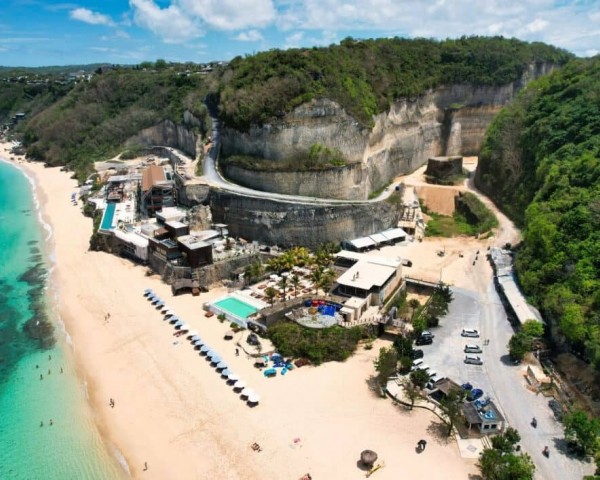As the sun’s rays play across the azure sea, the winding cliff road revealing Melasti Beach presents a truly breathtaking vista, all dazzling white sands and dramatic limestone cliffs. Just three short years prior, this secluded stretch was more or less unknown, a sacred site primarily for Balinese purification rites. Today, however, it welcomes well over a million visitors each year, quickly transforming into one of Bali’s most sought-after Instagram hotspots while still attempting to preserve its cultural soul.
A Cultural Crossroads
The morning breeze, often carrying the sweet scent of frangipani, witnesses a Balinese priest diligently placing offerings at a small seaside temple, a peaceful and serene ritual unfolding only a few meters from where DJs prepare their equipment for lively evening beach club events. This very juxtaposition neatly encapsulates Bali’s modern evolution, that is, a delicate dance between preserving ancient tradition and the demands of tourism. Melasti Beach, once a quiet ceremonial haven, now sees upwards of 9,600 visitors in a single day (according to a study in April 2025), even though it technically has no permanent residents.
Unlike the more crowded Bali beaches of Kuta or Seminyak, Melasti, generally speaking, manages to retain a certain spiritual essence. The traditional Melasti ceremony—where hundreds of devotees purify sacred symbols in the seawater itself—continues to attract local worshippers, even as tourists eagerly capture images of the dramatic limestone cliffs, reminiscent of Portugal’s Algarve, some 60-80 meters high. This unique “mini-Algarve with a Balinese heart,” as it’s sometimes called, offers a compelling blend of natural beauty and cultural depth, arguably setting it quite apart from some European counterparts, such as Mykonos, which swells to 50,000 tourists versus a local population hovering around 10,700.
A Tourism Boom with a Difference
The rather rapid rise of Melasti Beach closely mirrors global tourism trends but what makes it stand out is the noted lack of a resident population, creating a rather unique seasonal contrast not really seen in other destinations. Experts are currently predicting something like a 30% increase in the number of visitors in 2025, predominantly fueled by both the beach’s pristine beauty and, of course, its undeniable social media allure. Nature lovers especially drawn to Melasti will often venture to Indonesia’s other hidden gems, such as Teluk Ijo, with its gorgeous emerald waters, but it’s arguably the pronounced cultural transformation that truly captivates here.
The local Balinese BUPDA board appears to skillfully navigate this influx, effectively balancing the inevitable demands of mass tourism with the rather crucial need for continued cultural preservation. Daily Kecak dance performances, impressively staged by truly authentic village groups, enchant visitors while simultaneously honoring the deep-rooted traditions. Various sustainability initiatives (like biodegradable beach furniture and pretty strict regulations now in place for all beach clubs) aim to protect the delicate environment, kind of mirroring similar efforts already underway in places like the Seychelles, where such natural beauty faces similar pressures.
Navigating the Crowds
For, let’s say, the ultimate Melasti experience, timing is, in most cases, absolutely everything. Arrive before about 9 a.m. to fully enjoy the dramatic rocks and, of course, the crystal-clear waters in relative solitude, perfect for truly uninterrupted photography. The entrance fee is a very modest 10,000 IDR (roughly €0.60), with parking costing just 5,000 IDR. Unlike many other crowded Bali beaches, ride-sharing services are banned, so remember to plan your return trip relatively carefully. At low tide, natural swimming pools form delightfully among the coral formations, ideal for snorkeling or just safe splashing for the children. Local warungs generally offer fresh coconut water for around 25,000 IDR and quite affordable grilled seafood, further adding to the beach’s obvious charm.
For people seeking some quieter shores, Koh Mak, with its 27 kilometers of pristine beaches in Thailand, offers an alternative, but arguably it lacks the dynamic cultural narrative so present at Melasti. The beach’s affordability, not to mention its relatively easy accessibility, makes it a real standout destination, even though its rapidly growing popularity requires strategic planning so as to avoid the worst of the crowds.
A Solid Model for Sustainable Tourism
Melasti Beach in 2025 is much more than just a simple tourism phenomenon; it’s a particularly compelling case study in cultural balance. The local community’s apparently proactive approach—primarily limiting visitors during key religious holidays and strictly enforcing a number of eco-friendly practices—ensures the beach pretty much retains its undeniable spiritual and, indeed, natural allure. As global travel trends increasingly shift towards various destinations that effectively blend authenticity with accessibility, Melasti ultimately stands as a strong testament to Bali’s remarkable ability to evolve, but without losing its proverbial heart.
Whether you’re particularly drawn to the Instagram-worthy cliffs, the deeply sacred ceremonies, or even the vibrant fusion of both old and new elements. Melasti Beach, as a location, illustrates a destination that is striving to manage the complex realities of modern tourism successfully.

